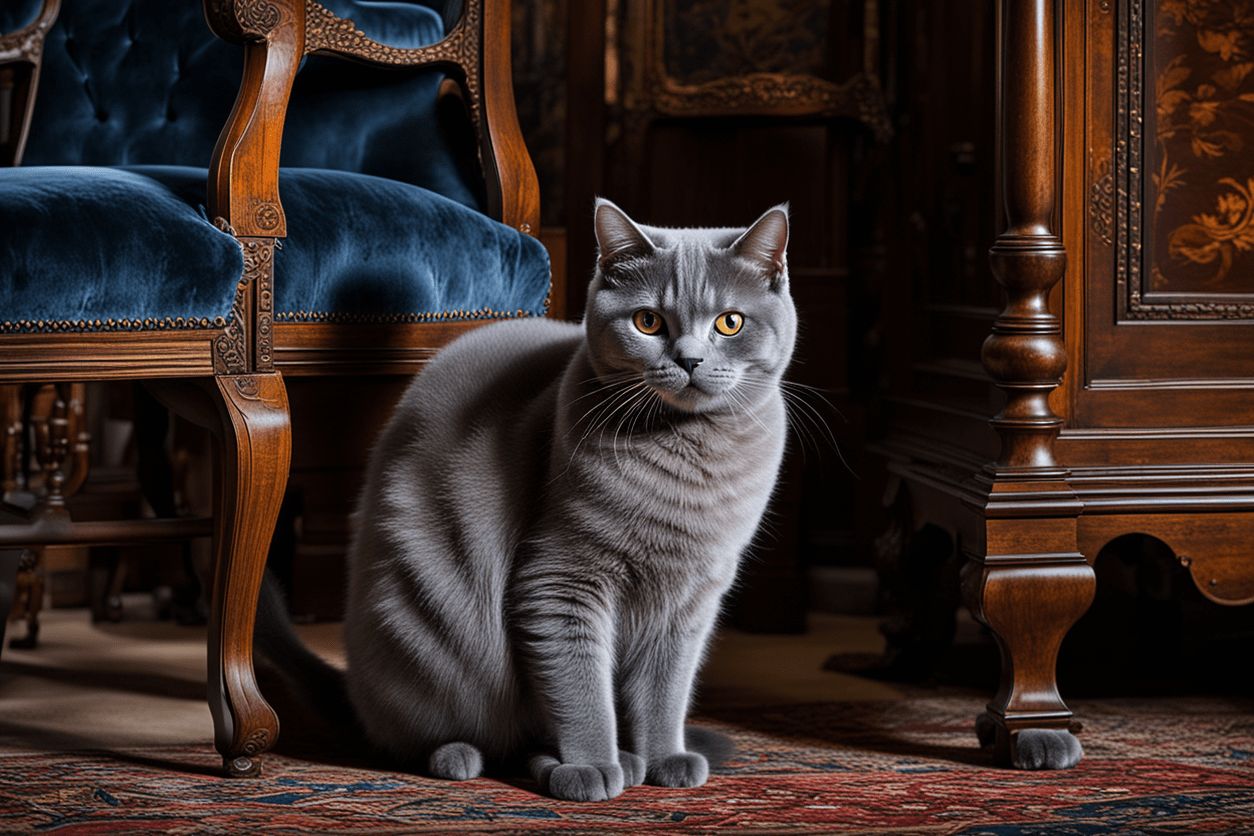Introduction
The British Shorthair is an iconic breed, gracing homes and hearts with its charming appearance and gentle demeanor. Known for their round faces and plush coats, these cats have gained popularity across the globe. They are celebrated for their calm temperament and adaptability, making them a beloved choice for many families.
History and Origin
The origins of the British Shorthair date back to ancient Rome, where they accompanied Roman soldiers to Britain. These cats interbred with native wild cats, evolving into the sturdy and resilient breed we know today. The British Shorthair gained recognition in the late 19th century, partly through the efforts of Harrison Weir, the “father of the cat fancy.” The breed was officially recognized by various cat associations, including the Cat Fanciers’ Association (CFA) and The International Cat Association (TICA), cementing its status in feline history.
Physical Characteristics
The British Shorthair is a robust and muscular cat, weight ranging from 7 to 17 pounds. Their coats are dense and plush, coming in various colors and patterns, but they are most famous for their “British Blue” coat. Distinctive features include their round faces, large round eyes (often copper or gold), and relatively short, thick tails. Their teddy bear-like appearance adds to their endearing mystique.
Personality and Temperament
British Shorthairs are known for their mild-mannered and placid nature. They tend to form strong bonds with their human companions, yet they maintain an independent streak. These cats usually get along well with other pets and children, preferring to observe the chaos rather than participate. While not as playful as some breeds, they enjoy interactive toys and moderate activity. British Shorthairs are also quite intelligent and can be trained for basic commands and tricks.
Health and Lifespan
Generally, British Shorthairs are healthy cats, boasting a lifespan of 12 to 20 years. However, they are susceptible to some genetic disorders, such as hypertrophic cardiomyopathy and polycystic kidney disease. Regular vet check-ups, a balanced diet, and preventive care can mitigate health risks and ensure a long, healthy life for your pet.
Grooming and Maintenance
Despite their dense coats, British Shorthairs require minimal grooming. Weekly brushing is adequate to remove loose hair and prevent matting. Bathing is seldom necessary, as they are generally clean animals. Routine maintenance should also include nail trimming, ear cleaning, and dental care to avert common health issues. A diet rich in high-quality protein, coupled with regular exercise, will keep them in optimal health.
Living Environment
British Shorthairs adapt well to various living situations, whether it’s a spacious house or a cozy apartment. They are particularly well-suited for indoor living, where they are safeguarded from potential dangers and harsh weather conditions. Providing them with enough space to explore and some interactive toys will suffice for their activity needs.
Interaction with Family and Children
This breed’s compatibility with children and other pets makes them ideal for family life. British Shorthairs are gentle and affectionate, handling kids’ playful energy with remarkable tolerance. They may not seek constant attention, but they thrive on the companionship of their human family. Their laid-back nature allows them to coexist peacefully with other household pets.
Adoption and Breeder Information
When seeking to add a British Shorthair to your home, it’s essential to choose reputable breeders who prioritize health and temperament. Research and ask for health clearances to avoid common genetic issues. Adoption is another excellent option, providing a loving home to a cat in need. Costs for British Shorthairs can range from $800 to $2000, depending on pedigree and breeding standards.
Fun Facts and Trivia
- The Cheshire Cat from Lewis Carroll’s “Alice in Wonderland” is said to be inspired by a British Shorthair.
- These cats are sometimes called “Brits” by their admirers.
- British Shorthairs are one of the oldest cat breeds in recorded history.
Frequently Asked Questions (FAQs)
What is the lifespan of a British Shorthair?
British Shorthairs typically live between 12 to 20 years.
Are British Shorthairs good with children?
Yes, their gentle and tolerant nature makes them excellent companions for children.
How often should I groom my British Shorthair?
Weekly brushing is generally sufficient to maintain their plush coat.
Do British Shorthairs like to be held?
While they are affectionate, they may not enjoy being held for long periods. They prefer to be beside you rather than on you.
Are British Shorthairs prone to any health issues?
They can be susceptible to hypertrophic cardiomyopathy and polycystic kidney disease.
What kind of diet is best for a British Shorthair?
A high-quality protein-rich diet is ideal to maintain their health and energy levels.
Can British Shorthairs be trained?
Yes, they are intelligent and can learn basic commands and tricks.
How much do British Shorthairs cost?
The cost ranges from $800 to $2000, depending on pedigree and breeder.
Are British Shorthairs indoor or outdoor cats?
They are best suited for indoor living but can enjoy supervised outdoor activities.
Are British Shorthairs social?
They are sociable with their human family but maintain a degree of independence.
Conclusion
The British Shorthair offers a perfect blend of charm, affection, and low-maintenance care. Their gentle nature and adaptability make them an ideal choice for various households. If you’re in search of a cat that brings both elegance and companionship, the British Shorthair may be the perfect addition to your family.

